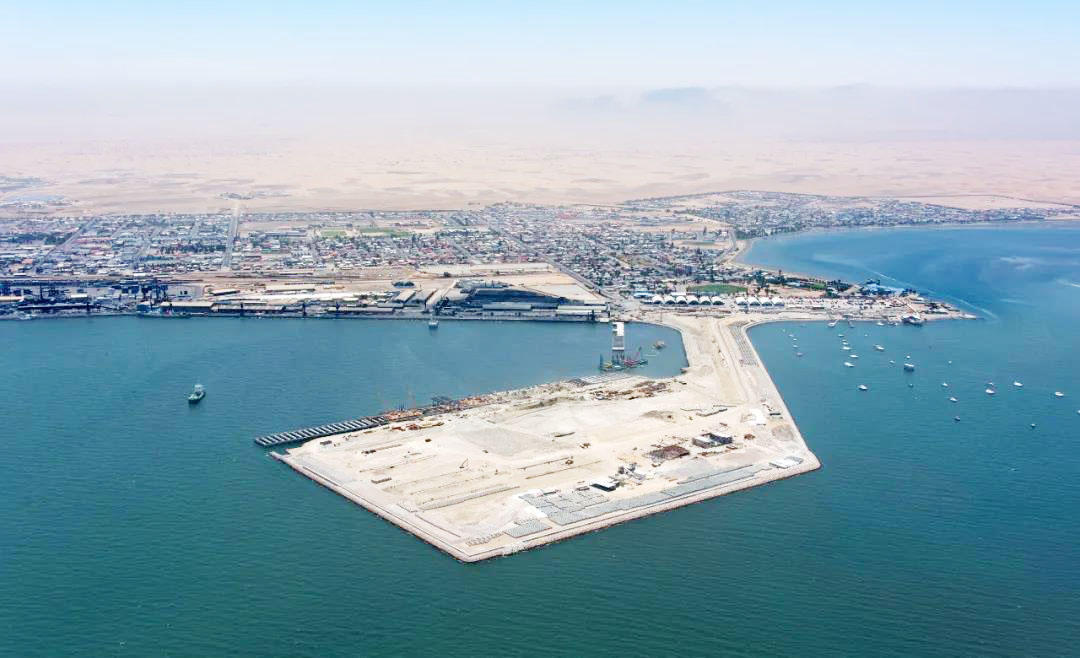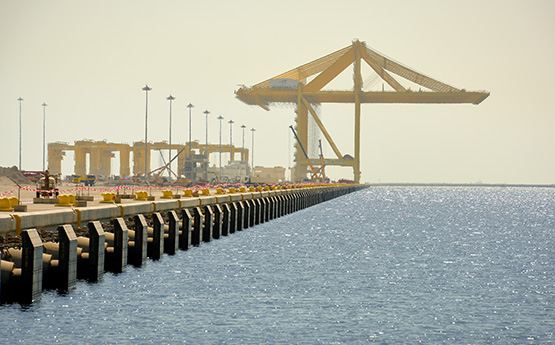
Project Name: New Container and Oil Terminals Project -Walvis Bay, Namibia
Host Country: The Republic of Namibia
Project Duration: May 2014 – August 2019
Project specification:
In October 2013, the CHEC won the spot exchange EPC full meaning? project of Walvis Bay New Container Terminal through fierce international bidding and the project is located in the old port area of Walvis Bay in Namibia The project construction consists of a container terminal that can dock 100000 tons of 8000 TEUs and has a coastline length of 600m, a 372m long cruise terminal, a 410000 m2 land storage yard (including 3.6 million m3 of dredging and 2.7 million m3 of reclamation). The project further consists of a floating water-break for yachts, and corresponding supporting facilities such as railways, highways, hydropower, communication, and housing construction, and 4 shore bridges.
As well, in October 2014, the CHEC won the spot exchange EPC project of Walvis Bay Oil Terminal bidding and the project is located in the new port area north of Walvis Bay. The project consists of two 60000 DWT oil tanker berths and two 400 DWT tugboat berths, 730m of the quay, 1700m of approach bridge, 8.9 million m3 of dredging, 7.6 km of water and land oil pipelines, including a total of 75000 m3 of oil storage area for diesel, gasoline, aviation kerosene, and heavy oil and other supporting facilities. The oil depot area is located in the oil and gas industrial zone on the northeast side of Walvis Bay, with an area of 2.6 hectares, which is functionally divided into a tank farm, vehicle, train loading and unloading area, production auxiliary area, etc.
Characteristics and Significance of the Project:
Namibia is located in Southwest Africa, with a land area of 820000 sq. km, a population of 2.5 million, and a coastline of 1600 km. The whole coastline is the world's oldest desert - the Namib Desert. Namibia, also one of the youngest countries in the world, was founded in 1990. The pillars of the national economy are mining, fishery, agriculture, animal husbandry, and tourism. Namibia has relatively complete infrastructure, but most of them are left over from the colonial period before the founding of Namibia and tends to be old. Walvis Bay Port is located on the west coast of the Atlantic Ocean and is the largest port in Namibia and a tourist city.
Since 2005, Walvis Bay Port has been under new planning, not only the core logistics hub of Namibia, but also an important port in the whole southwest of Africa, an import and export hub of Botswana, Zambia, Zimbabwe, and other surrounding landlocked countries. Through the project construction, the annual throughput of the container terminal of Walvis Port will increase from 300000 TEUs to 700000 TEUs, and the loading and unloading efficiency will achieve a qualitative leap. The oil terminal will also become the first national strategic oil storage facility owned by the Namibian government, and the storage time will increase from 15 days to 30 days.
The project has three technical challenges as follows:
1)The geological conditions are complex, and the underwater mud bed contains 20m thick diatomite with strong compressibility, which is extremely rare in international engineering industry. The project found a feasible solution through technology and design breakthroughs.
2)The mud layer contains highly toxic hydrogen sulfide gas, and serious safety risk . The project department has effectively controlled the threat of hydrogen sulfide by strengthening the safety operation regulations, optimizing the ship engine transformation scheme, allocating international management resources and various detection and protection facilities, and establishing a linkage mechanism with the owner and the community.
3)Walvis Bay is the second most severely corroded area in the world. The concrete structure of the project, especially the oil terminal, pipeline, and equipment related to the process in the reservoir area in the oil terminal project, has high requirements for corrosion protection.
As Namibia is the first country to write environmental protection into its constitution and is one of the best countries in Africa to protect the original ecology and environment, the Walvis Bay with many tourism resources and an oyster breeding base nearby, the task of environmental protection is important. The project department worked hard on the construction process first, and entrusts professional institutions to carry out 24-hour detection of water quality and noise. The project also cooperates with local cooperative institutions to study the impact of operation activities on dolphins and with international non-profit organizations to carry out wildlife protection publicity in the project. Despite Namibia's safety management standards being very high, the container terminal project has achieved 5 million non-destructive safety working hours, which was praised by stakeholders of all walks of life. Also, despite the design and construction standards of the project adopting European, American, and South African specifications with strict requirements, the project department actively persuaded the owner to adopt Chinese standards in some aspects and promoted Chinese standards to go abroad.
The oil terminal project covers a variety of two-way oil receiving and dispatching processes for product oil terminals, terminal loading and unloading, pipelines, storage areas, and oil distribution, promoting the accumulation of experience for further development of the CHEC in the oil and gas industry.
Adhering to the CHEC's values of "perceived responsibility, high-quality return, and win-win cooperation", the project department actively realized its task of corporate social responsibility locally. As such, the project has created more than 2000 local jobs, trained more than 600 skilled workers through theoretical study, on-site practice, and on-the-job training for local employees, and also trained 70 employees through local qualified professional institutions. In the local area, CHEC has actively carried out donations to help students and help people in distress, with a total donation of 3 million Namibian dollars. Among them, it has sponsored two Namibian youths to study engineering at Hohai University in China for five years. It has also provided “practical opportunities” for local college students in the project and established a good image of Chinese enterprises in the local area.

- Abidjan Port Expansion Project -Côte d'Ivoire
- In the Abidjan Port Expansion Project, the construction process consists of a new container terminal with three berths in total. The total length of the quay coastline is 1312m, and the water depth of the terminal structure is - 18 m, forming a land area of 37.8 hectares, an...
- More>>

- Doha Qatar New Port (NPP) Project -Doha
- The construction contract undertaken by the CHEC is Phase I of the project, with a contract amount of about 880 million US dollars consisting of 11 terminals, i.e. container terminals (number1 to 3), general cargo terminals, vehicle terminal yacht terminal, maritime termin...
- More>>
 Global office
Global office
 contact us
contact us